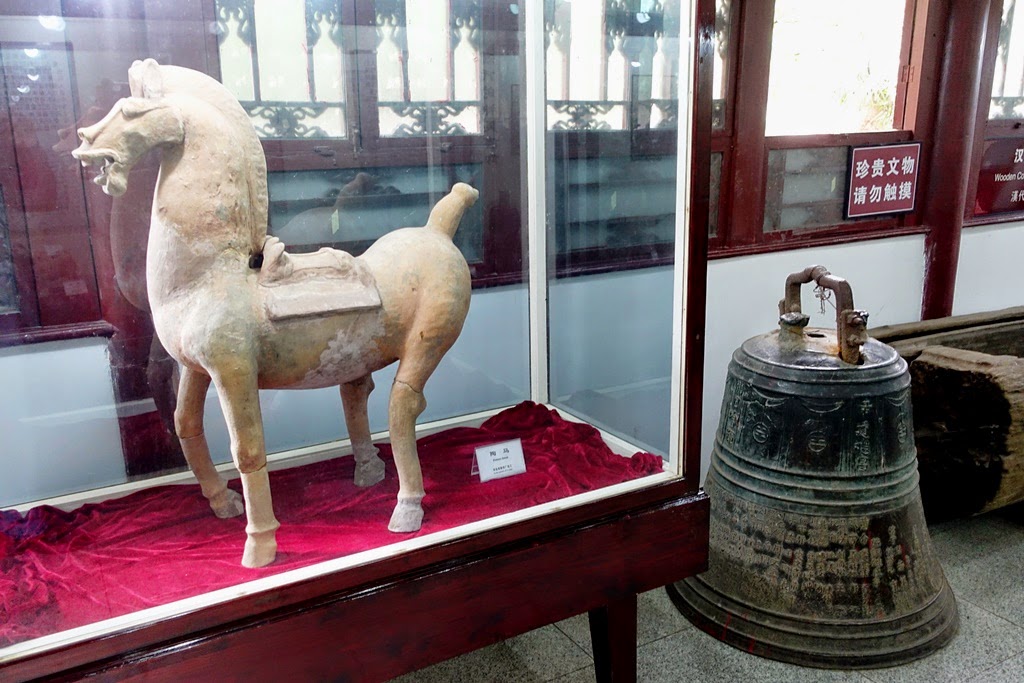It's a funny thing: I'm terribly afraid of heights. Watching YouTube videos of daredevils dancing around atop unfinished skyscrapers, of workmen climbing up radio towers or of Chinese hikers walking along narrow ledges while facing thousand-foot drops always leave me with an uncomfortable feeling in my bowels. Conversely, however, I find myself drawn, like a moth to a flame, to places such as mountain top lookout points and skyscraper observation floors. Which is how we came to be in Pŭdōng 浦东 this afternoon (Saturday), to visit the 492 meter (1614 feet)-high Shànghăi World Financial Center 上海环球金融中心. Lonely Planet describes it as "astonishing"; "disappointing" would be more accurate...
Looking out over Lùjiāzuĭ 陆家嘴 after lunch at a Japanese restaurant in the IFC Mall, we were surrounded by the district's highrises. In the photo below, the building on the left is the Jīnmào Tower 金茂大厦, which we visited last October; on the right is Shanghai Tower, the second-tallest building in the world and due to open at some point later this year, though it'll probably happen after we've left:
I've been told that fifteen or twenty years ago, Lujiazui was still primarily a rural area:
Approaching the Shanghai World Financial Center. The building's most distinctive feature is the "bottle opener" at the top. The story goes that the original design called for a circular opening, but some people found that too uncomfortably close in appearance to the Japanese Red Sun, so the shape was changed to its present rectangular oblong. Every time I see this building, I always have the urge to drink a bottle of beer:
It wasn't cheap to get in - 180 RMB ($29) for an adult for a ticket to the 94th, 97th and 100th floors (children under 140 centimeters in height are half price, and the staff carefully measured my daughter to see if she should be charged the full price - she barely qualified for the child's fare). The views from the 100th floor (the top of the bottle opener section), unfortunately, were not spectacular enough to justify the steep cost (or to validate the guidebooks' enthusiasm). What had started out in the morning as a clear blue sky had turned a little hazy by the time we finally made it to the top floor, which isn't the fault of the company managing the observatory. However, they certainly could've installed windows that would've allowed clearer views (and photos). We saw more of Shanghai when we visited the Jinmao Tower and the Oriental Pearl TV Tower 东方明珠广播电视塔, both of which could be seen from the windows of the SFWC:
The view from the opposite bank of windows on the floor was actually more interesting, as the sprawl of housing developments stretched out toward the horizon:
We could also look down on a luxurious condo complex:
There was a lot of traffic on the Huángpŭ River 黄浦江:
The sections of the floor with transparent glass made Amber very nervous:
We then made our way down to the 97th floor, the bottom part of the bottle opener, where the views through the glass were marginally better:
My daughter felt better on more solid flooring:
The last floor, the 94th, had the least interesting views, but was the best of the three, thanks to the cocktail bar located there. The Shanghai World Financial Center lacks a 360-degree vista, but it does offer the Sky 94:
Back on terra firma, and walking through the nicely-landscaped Lujiazui Park (the statues need to go, however):
Amber made some foreign acquaintances there:
The verdict on the SWFC is that it isn't worth the exorbitant admission fee. That being said, the Park Hyatt Hotel between the 79th and 93rd floors probably does provide amazing views for its guests (if the smog cooperates and stays away). And as our time in Shanghai is starting to wind down, at least another item has been checked off the bucket list. Pudong accomplished...well, almost:





















































